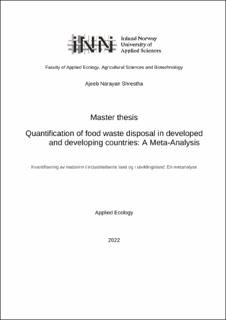| dc.contributor.author | Shrestha, Ajeeb Narayan | |
| dc.date.accessioned | 2023-02-17T14:11:12Z | |
| dc.date.available | 2023-02-17T14:11:12Z | |
| dc.date.issued | 2022 | |
| dc.identifier.uri | https://hdl.handle.net/11250/3052028 | |
| dc.description.abstract | Matsvinn er et aktuelt problem, der avfall genereres gjennom alle ledd i verdikjeden, og dette skjer i så vel utviklede som utviklingsland. Økende bekymring for matsikkerhet og miljøpåvirkninger tilskrevet matsvinn på grunn av økt arealbruk og utslipp av klimagasser under produksjon og i verdikjeden. En systematisk litteraturgjennomgang ble utført for å avdekke hvor i verdikjeden problemene er størst og for å observere om det er forskjell mellom industri- og utviklingsland. Forskningen fulgte meta-analyse tilnærming med en syntese av referanser med data om matsvinn. Både kvalitative og kvantitative data ble samlet fra artikler som ble funnet gjennom via Google Scholar og ISI Web of Science. Analyse og datatolkning ble gjenomført from fem industrilland og for fem utviklingsland, og dette le gjort gjennom hele verdikjeden fra inghøst til forbrukernivå. Identifisering av mattap i utviklingsland fra etterhøst til forbrukernivå og matsvinn i utviklede land på forbrukernivå. Identifisering av skadelige effekter av matsvinn i miljø, økonomi og matsikkerhet. Det er et stort behov for dialog mellom aktører i verdikjeden, fra produsenter til forbrukere, for å implementere strategier for å redusere matsvinnet. Med en befolkning som er estimert til å være 9 milliarder innen 2050, og med reuserte naturressurser, er økt produksjon ikke eneste løsning, men reduksjon av matsvinnet må også inkluderes.Utnyttelsen av naturressurser (land, vann og energi) for å brødfø den voksende befolkningen vil resultere i alvorlige miljø messige og økonomiske konsekvenser. | en_US |
| dc.description.abstract | Abstract: Food waste is an urgent problem, where waste is generated through all stages of the value chain, and this happens in developed as well as developing countries. Increasing concern about food security and environmental impacts attributed to food waste due increased land use and the emission of greenhouse gases (GHS) during production and value chain. A systematic literature review was performed to detect where in the value chain the problems are the highest and to observe if there is a difference between developed and developing countries. The research followed Meta-analysis approach and synthesised reference with data on food waste. Both qualitative and quantitative data were collected through references found by using Google Scholar and ISI Web of Science as search engines. Analysis and data interpretation were made for five developed countries and five developing countries, and this was done through its value chain from post-harvest to consumer level. Identified that major food loss in developing countries take part post-harvest and before it reaches to consumer level, while food waste in developed countries takes place more at the consumer level. Identification of the detrimental effects of food waste on environment, economy, and food security are discussed. There is an urgent need for dialogue between actors in the value chain from producers to consumer, to implement strategies to reduce food waste. With an estimated population of 9 billion by 2050, and with limited natural resources, increased production is not the solution. Reducing food waste is the part of the solution as exploitation of natural resources (land, water, and energy) to feed the growing population will results in serious environmental and economic consequences. | en_US |
| dc.language.iso | eng | en_US |
| dc.publisher | Høgskolen i Innlandet | en_US |
| dc.subject | food waste | en_US |
| dc.subject | food loss | en_US |
| dc.subject | post-harvest loss | en_US |
| dc.subject | developed countries | en_US |
| dc.subject | developing countries | en_US |
| dc.subject | value chain | en_US |
| dc.title | Quantification of food waste disposal in developed and developing countries: A Meta-Analysis | en_US |
| dc.title.alternative | Kvantifisering av matsvinn i industrialiserte land og i utviklingsland: En metanalyse | en_US |
| dc.type | Master thesis | en_US |
| dc.subject.nsi | VDP::Landbruks- og Fiskerifag: 900 | en_US |
